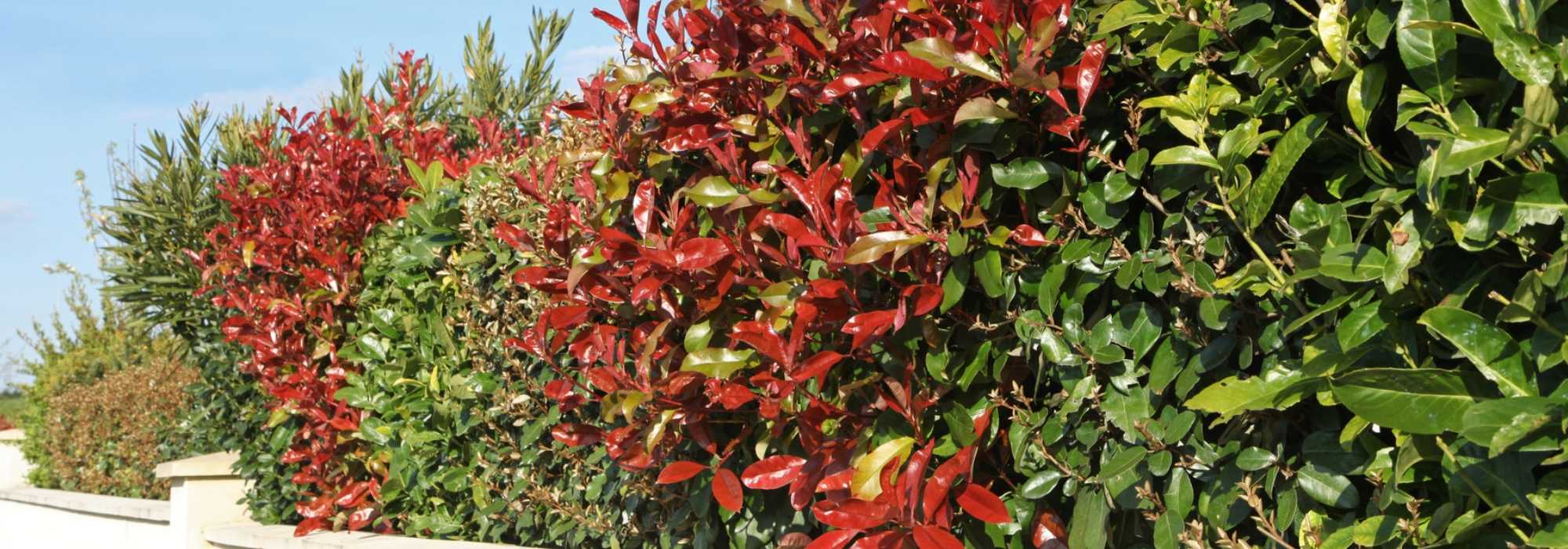
Which bushes or shrubs for which types of hedges?
Plants suited to every use and situation
Contents
It’s rare not to need a hedge in our gardens, if only to mark out our plot or to screen part of it for more privacy. Hedges of evergreen bushes are perfect for that, but let’s not forget flowering bushes, so pleasant in all seasons, nor thorny bushes, which deter intruders.
Moreover, some parts of your garden may seem problematic: a very shady corner, for example… Perhaps you think that no bush will be able to grow in your particular soil or by the sea?
Think again: there are hedge bushes for every purpose and every situation! And we prove it by offering you a few examples.
Evergreen hedge with rapid growth
To screen part of the garden, what better than a fast-growing evergreen hedge? In my top three I name: Privet (Ligustrum), Photinia, Prunus laurocerasus, also called cherry laurels.
The scent of privet (Ligustrum) flowers reminds me of the start of the summer holidays. Sadly most people prune it before its flowering. Never mind, its evergreen foliage and remarkable hardiness have earned it the title of “champion of the evergreen hedge”.
Photinia has been so often misused that it ends up giving gardeners hives. Yet few evergreen bushes are as beautiful all year round. Its young red foliage lights up the garden and, if you let it grow freely, its spring flowering will reward you with an elegant scent.
Another well-known bush, yet so little appreciated: Prunus laurocerasus. It grows quickly, withstands almost anything and tolerates pruning admirably. For all these reasons cherry laurel is found wherever there is a need to create a screen of greenery quickly. For it too, less systematic pruning will bring a flowering much appreciated by pollinators.
Note also that if you need to screen part of your garden to protect yourself quickly from wind, Elaeagnus or oleaster is the bush you need. Evergreen, it grows quickly too and has silvery-grey foliage. It is an excellent windbreak.
All these bushes can achieve growth of 30 to 50 cm per year and can be pruned tightly. But, to do so, and especially for cherry laurel and photinia, do not use a hedge trimmer which would damage the foliage; prefer the pruning shear or the shear. If you let them grow freely you will also benefit from their flowering and fruiting.
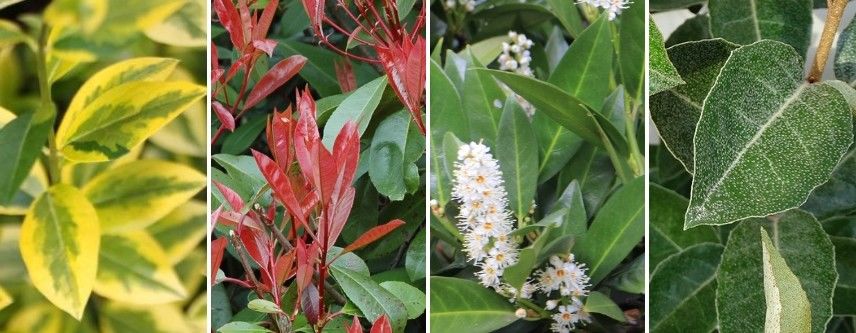
Ligustrum ovalifolium ‘Aureum’ – Photinia fraseri ‘Red Robin’ – Prunus laurocerasus ‘Caucasica’ – Eleagnus x ebbingei
→ In a hurry to screen your garden from view? Do not hesitate to call on speed record-holders! Discover them in our advice sheet: “Fast-growing hedge: 10 trees and bushes that grow quickly”
Country hedge
Hedges that once populated our countryside have almost all disappeared. To great misfortune of wildlife that found refugium and food there. A countryside hedge is composed mainly of local essential oils that may vary by region.
In south of France, you will mainly find strawberry tree, holm oak, bay laurel or buckthorn; in montane regions, you may encounter Amelanchier ovalis, Alpine rose or holly; in coastal areas, for example, sea buckthorn or tamarisk. These essential oils, adapted to terroir and regional climate conditions, are robust, rarely affected by disease and allow establishment of long-lasting hedges!
Blackthorn and Guelder rose as well as European spindle will complete the picture with their flowering, fruiting and pretty autumn colours.
The blackthorn has so many qualities it could be used in many situations (defensive hedge, flowering hedge, fruiting hedge…). This thorny, bushy bush flowers in early spring. Its fruits, although inedible during the season (except for birds!), need a touch of frost to become almost edible and to be used for making various spirits, for which almost every region probably has its own recipe. Another advantage, or drawback depending on viewpoint, is that it sends out suckers prolifically, forming in just a few years a dense and practically impenetrable thicket.
The Guelder rose is astonishingly easy to grow. Its white flowering in spring is followed by bright red fruiting which, besides being very decorative, attracts all the local birds like a magnet. But it is not only its fruits that turn scarlet; its foliage, first dark green, becomes bright red in autumn, thus extending interest in this bush.
The European spindle (do not force me to write its Latin name with its 11 vowels!) is also a champion of crimson tones in autumn. But it is mainly its orange fruits, set off by its strange red-pink capsules, that will catch your eye. Otherwise, for cultivation no problem: European spindle or Bonnet d’Évêque is perfectly suited to most soils and to our climate.
Finally, if you want to give nature a little helping hand while enjoying beautiful flowering, plant a Cornus mas, which delights with its yellow flowers in spring and delicious cornelian cherries in early autumn.

Prunus spinosa – Viburnum opulus ‘Compactum’ (©Horticolor) – Euonymus europaeus ‘Red cascade’ (© Horticolor)
→ Discover :
- our Eco Countryside Hedge kit, an excellent solution for planting long hedges at low cost
- our advice sheet on: 9 bushes for a bocage hedge
- our video and advice to create and maintain a countryside hedge
Discover other Hedge shrubs
View all →Available in 0 sizes
Available in 1 sizes
Available in 1 sizes
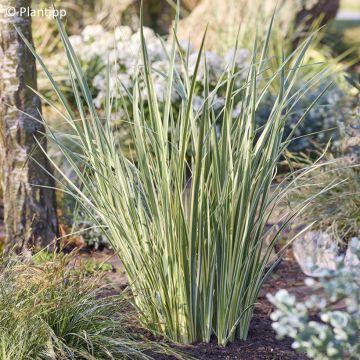
Available in 1 sizes
Available in 1 sizes
Available in 1 sizes
Available in 1 sizes
Available in 2 sizes
Available in 1 sizes
Available in 1 sizes
Defensive hedge
Once used to contain livestock, deterrent hedges now mainly serve to stop dogs or ill-intentioned people (tax inspectors, neighbour selling raffle tickets, etc.) from entering properties, even modest ones! Spiny bushes, whether evergreen or not, that tangle together to form an impenetrable wall can be achieved in very little time. Try combining Berberis julianae, holly and pyracantha. It pricks, it claws, it tears, it scratches… In short: it hurts. Nothing or no one will get past this thorny barrier. Result guaranteed! (otherwise, consider installing barbed wire…)
Berberis julianae is found in every deterrent hedge thanks to its reputation for being prickly and for growing almost anywhere. In addition, its yellow flowering, although discreet, often occurs twice a year just before its evergreen foliage reddens at first frosts.
Hollies – Ilex aquifolium are not just for pretty Christmas decorations; they are also very attractive bushes (even trees if left to grow freely). There are numerous different varieties, the finest distinguished by evergreen leaves variegated with yellow or white. Growth is fairly slow in early years but it is practically indestructible, which is its strength. Note also that only female plants can fruit.
Pyracantha is every gardener’s nightmare… when it comes to pruning. But if you decide to leave it alone or only trim a few unruly branches (that’s what I do at home!), it will cause no trouble as it is also very hardy and adaptable. Its evergreen foliage provides a splendid setting for small orange, yellow or red berries that will delight birds when cold weather arrives…
Warning! The downside to these spiny bushes is maintenance, which is no picnic when it comes to clearing hedge trimmings. Be sure to wear thick gloves and protective goggles for pruning. And collect cuttings with a fork; hands and forearms will thank you. Don’t forget that all gardeners should be up to date with tetanus booster.

Berberis julianae – Ilex aquifolium ‘Argenteomarginata’– Pyracantha ‘Orange Glow’
→ Fancy a simple, practical solution? Discover our ready-to-plant kits: “Deterrent hedge” and “Evergreen and deterrent hedge”
Flowering hedge all year round
As you might expect, a bush that flowers from January to December does not exist. If you want to obtain a flowering hedge all year round, you will need to plant different species that will flower throughout the year. Many bushes flower in spring and are often planted in gardens. Let us therefore focus on those that flower in winter and in late summer and autumn, which are a little rarer.
Summer and autumn flowering
Among bushes that flower from late summer to early autumn, I immediately think of a Buddleia… but not just any: Buddleia (x) weyeriana will make you forget the perennial “butterfly bush” with its panicle inflorescences usually blue-violet, because this one blooms a striking yellow between late August and October and its flowers appear as balls.
Heptacodium miconioides, everyone talks about it and… nobody plants it. That is a mistake! Few bushes have so many qualities: extremely hardy, undemanding, wonderfully beautiful from late summer thanks to its flowering (from late August to October), its fruiting that closely follows and its purple autumn foliage. Even though it is magnificent planted on its own or alongside some shrubs or perennials at its feet, you can nevertheless try it in a loose flowering hedge.
Flowering can easily be extended until the first frosts with a Camelia sasanqua, an autumn camellia with evergreen foliage flowering from November to December. My little favourite is the charming variety called ‘Frosted Star‘ (frosted star…) with white flowers tinged with pink.
Winter flowering
Among bushes with winter flowering, you could try an Abeliophyllum distichum; this bush looks remarkably like a Forsythia… that someone forgot to give its yellow colour. The ‘roseum‘ variety is, as its name suggests, pink-flowering. Give it a sunny spot to ensure its wood matures and resists frost.
Do not be put off by the extravagant name of Edgeworthia chrysantha, because it is a true gem. The paperbush, as it is affectionately nicknamed, will enchant you with its silky pom‑pom flowers in yellow or orange between February and March. Absolutely worth discovering!
And why not finish winter in style with a Stachyurus chinensis. This bush, still too little known, is adorned between March and April, just before leafing, with clusters of small cream‑white bells tinged with green and yellow. Stachyurus is also splendid when it dons its autumn colours, turning from yellow to deep reddish‑purple.

Camellia sasanqua ‘Frosted Star’, Heptacodium miconoides, Edgeworthia chrysantha, Stachyurus chinensis ‘Celina’
→ also to read on the blog: “Flowering hedge: which bushes to plant, when and how”
Hedge in the shade
Yes, you read that right! A shade-loving hedge is entirely possible. Haven’t you ever seen bushes under a tree? Mmm… Yes, that’s it: hydrangeas, rhododendrons…
But don’t stop at those few specimens. Many other bushes will flower with very little sun during the day. Here are some examples…
Take the case of Choysia ternata ‘Sundance’ which will brighten your little shady spot with its golden-yellow foliage. And its flowering smells so much of orange blossom that it would be a shame to miss out…
If it feels lonely, pair it with Osmanthus heterophyllus ‘tricolor’. It looks like a holly… It has holly’s colour… but is not one! Try feeling the leaves — they are much less prickly than Ilex aquifolia (which can also grow in shade, by the way…). Also, if you wait until late summer, it will reward you with white flowering scented with jasmine. It is still unfairly little known for now, but wait a little and it will be everywhere!
A bush that has been seen everywhere is Aucuba. But one must admit it does its job admirably. It grows in all soils, its foliage punctate with yellow brightens the darkest corner of your garden and it bears ruby-red fruits at the end of summer that will persist until winter (only on the females because it is a dioecious species, that is to say there are male and female plants). So leave your prejudices at the cloakroom and make room again for this accommodating bush.
Coastal hedge
Everyone keeps going on about drawbacks of gardening in these locations: too windy, too salty, too sandy… (probably too much iodine as well!). But people forget to tell you that gardening by the sea, even though it’s hard to generalise, brings huge advantages. Brighter light, springs that warm up earlier and longer summers are all assets in your arsenal for creating a superb coastal hedge.
The Griselinia littoralis, a New Zealand bush of the dogwood family, is a classic of seaside gardens. And for good reason! It wasn’t named «littoralis» for nothing. It grows quickly, has evergreen foliage and bears a spring flowering that, while discreet, is very melliferous.
Escallonia is another must-have for coastal gardens. Although it is hardy enough to be found inland as well. Evergreen and bushy too, it stands out for a multitude of small pink buds that open into pale pink flowers, fading to white over time.
The Ebbingei oleaster is a hybrid of two other Elaeagnus. Also evergreen and bushy like its two companions described above, it is notable for superb silvery-grey foliage. You can prune it or let it grow as you please.

Griselinia littoralis – Escallonia ‘Apple Blossom’ but ‘Donard Seedling’ would be equally suitable (©Horticolor) – Elaeagnus x ebbingei
A hedge adapted to your soil
Trying to change your soil to grow plants that do not suit it is not only tedious but also very costly. So why not choose to plant only, or at least mostly, plants that adapt easily to your ground. There are plants for every soil type. However, two soil types often raise questions when planting a hedge: calcareous soils and heavy, clay soils.
1) On calcareous soil
These alkaline soils (pH above 7) allow water to drain, which is a good thing, but sadly nutrients are quickly leached and therefore less available to plants. This is not a bad soil (remember that a “bad soil” does not exist!) because limestone favours breakdown of organic matter. You can improve your soil by sowing green manure at the end of the season or by adding a little well‑rotted manure. There are nevertheless many plants that cope very well with such soil.
Decorative dogwoods with attractive stems such as Cornus alba have a reputation for withstanding almost anything (not to be confused with flowering dogwoods such as Cornus kousa or Cornus florida, which do not tolerate limestone…). And that reputation is well earned! I can recommend Cornus alba sibirica ‘variegata’ but my favourite remains Cornus alba ‘aurea’. Whichever you choose, you will be delighted. There are many different varieties and cultivars and even the single Cornus alba sibirica is splendid. They are all magnificent both in season for their foliage and white fruiting (hence the term alba) and in winter for their bright red stems. So adopt them without delay!
To contrast with a Cornus alba ‘aurea’, an ideal choice would be Cotinus coggygria ‘Royal Purple’, but why not try the sumptuous Cotinus coggygria ‘Golden Lady’ in a fresh green. This one, like its purple sibling, will charm you with its summer flowering in a “smoke” effect.
Back to dogwoods with a classic of calcareous soils, Cornus mas or cornelian cherry (nicknamed by Didier Willery the “Mimosa of the North”). Another little wonder. One of the first to flower in spring and one of the first food sources for insects. It will also be very beautiful with its autumn colours, ranging through shades of brown‑red and laden with cornels. If you do not like its fruits, birds will take care of them illico presto.
Note: we have in nursery Cornus mas ‘Jolico’, an excellent small tree better classified among fruit trees and therefore to plant in an orchard. For a hedge, stick to a simple Cornus mas.
You can also add a lovely wayfaring tree or Viburnum lantana ‘Mohican’ which will delight you with a beautiful white spring flowering followed by fruit that will attract birds.

Cornus alba ‘Aurea’ – Cornus mas ‘Aurea’ – Cotinus coggygria ‘Golden Lady’ – Viburnum lantana ‘Mohican’
→ to discover: our flowering hedge kit for limestone soil
2) On clay soil
Clay soils are heavy and difficult to work. Furthermore, they warm up (too) slowly after winter. But… they are also very fertile and retain water well. A simple addition of lime and organic matter in autumn will be enough to improve texture of this soil. Many trees and bushes appreciate sinking their roots into this sticky yet generous soil.
It is not just ornamental apple trees that like clay soil. In fact, they adore it! They are crazy about it! So plant one straight away (or two… or three). Magnificent in spring when they are clad in snowy blooms, splendid at the end of summer when they offer small edible apples (act quickly! You are not the only fans…), glorious in autumn when they burst into flamboyant colours and… even in winter, their fissured barks often adorned with mosses and lichens will brighten the dull season. If you have clay soil, bushes are what you need.
Another lover of clay is hawthorn. In fact, most shrubs of the rose family cope perfectly (apple trees, blackthorns, roses, …). One of the most beautiful cultivars does not flower white but a deep pink: Crataegus laevigata ‘Paul Scarlet’.
To complete the picture, choose one of the sturdiest and most charming bushes from our flora (in flower as well as in fruit): Sambucus nigra, the humble elder. Several varieties exist that can easily rival some Japanese maples for the beauty of their foliage.

Malus ‘Golden Hornet’ (©Horticolor) – Crataegus laevigata ‘Paul Scarlet’ – Sambucus nigra ‘Black Lace’
→ to discover: our flowering hedge kit for clay soil
- Subscribe!
- Contents
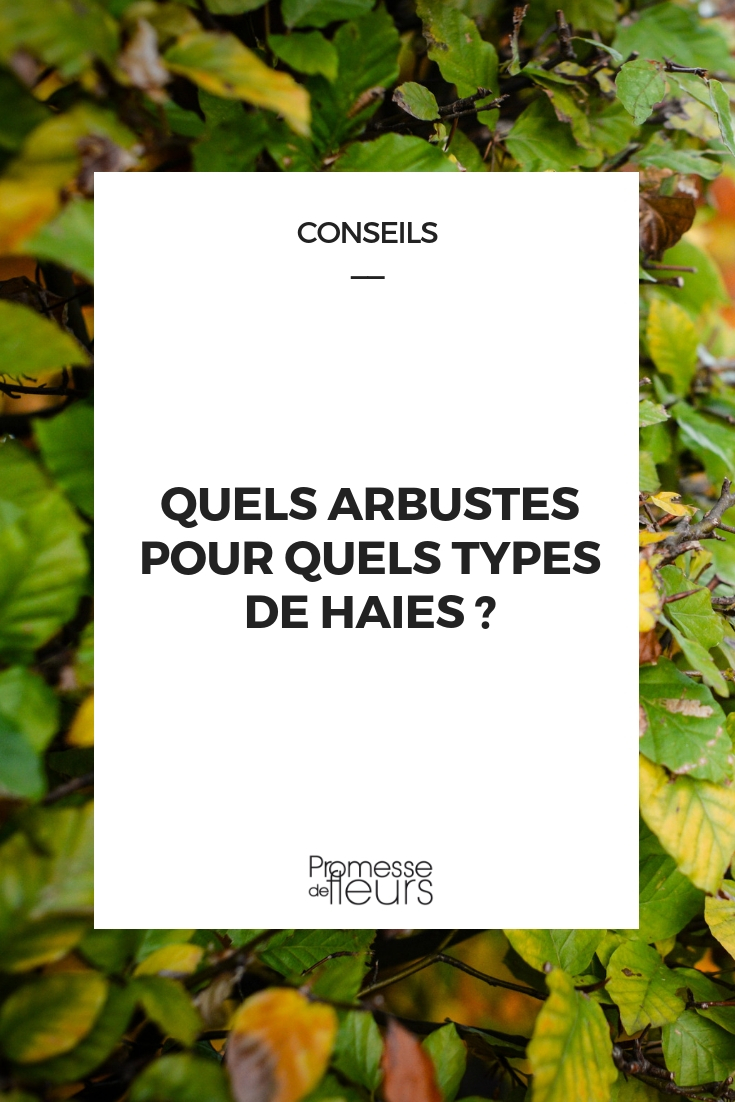

































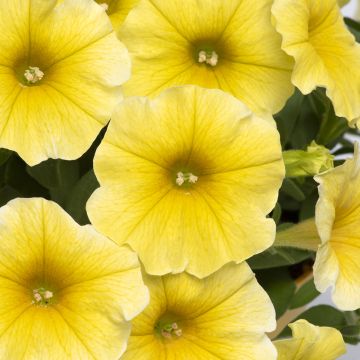
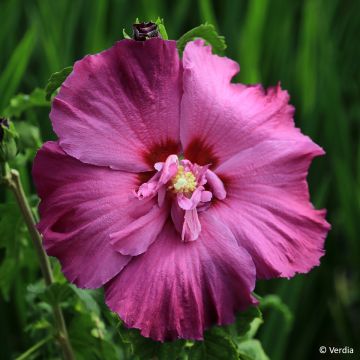
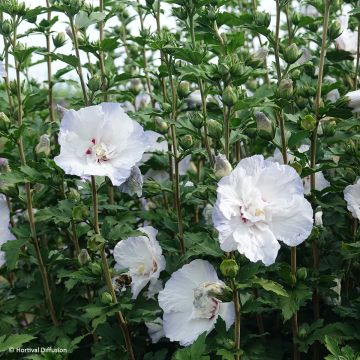


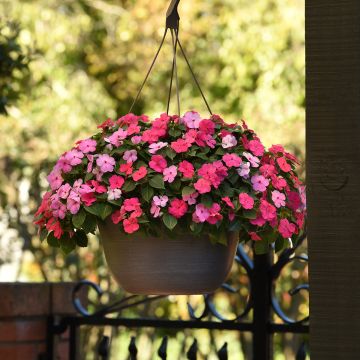
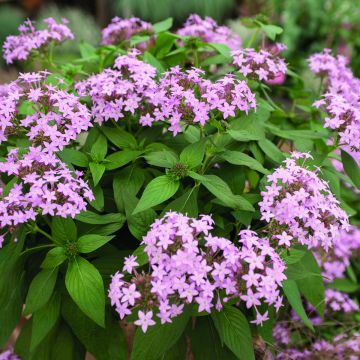

Comments